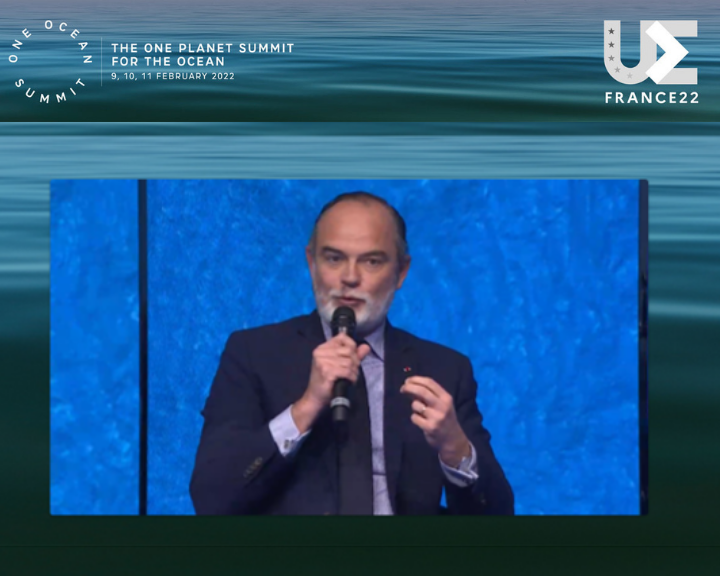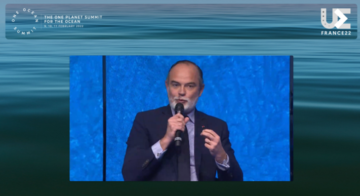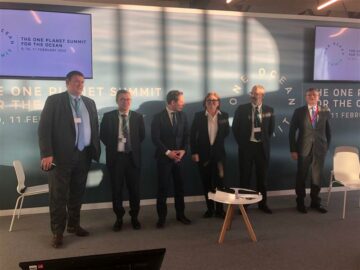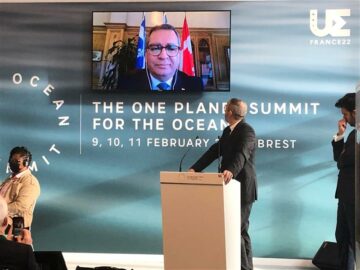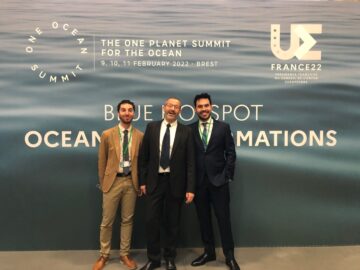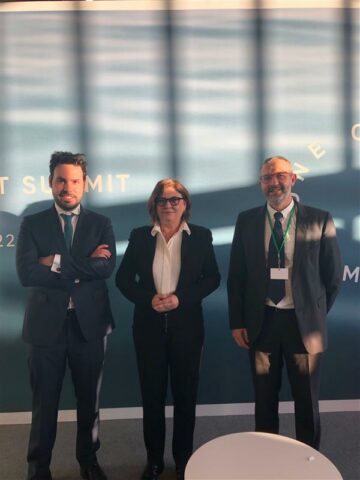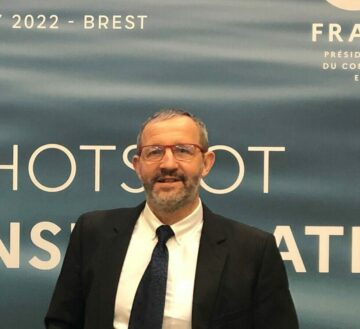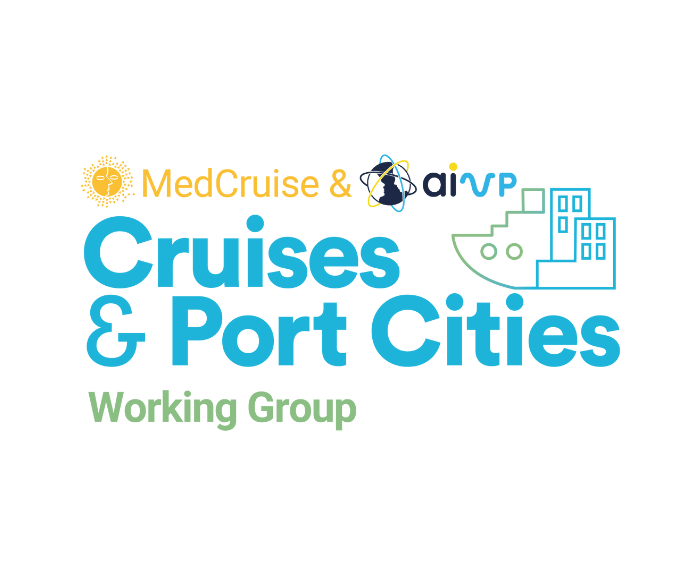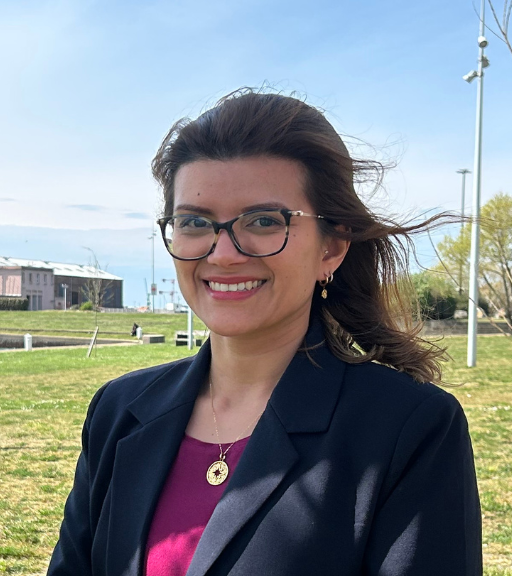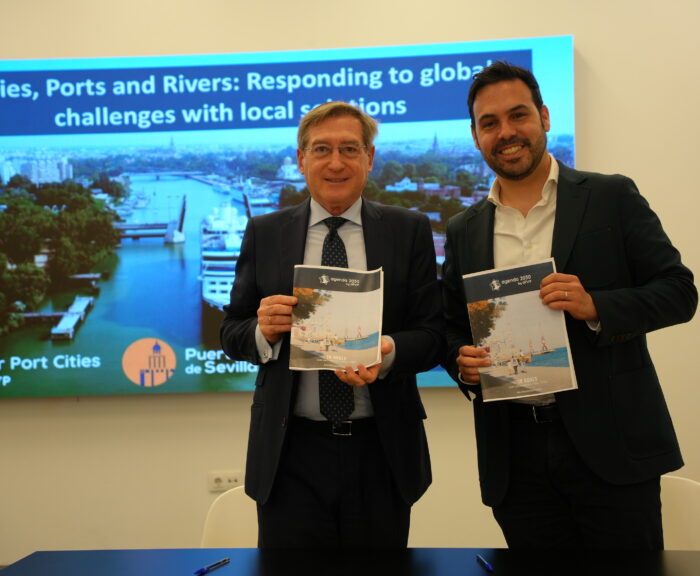One Ocean Summit, Brest, 9, 10, 11 febrero 2022
Edouard Philippe, Presidente de la AIVP, y Mario Girard, Vicepresidente de la AIVP, se han comprometido en nombre de las ciudades portuarias con la transición ecológica durante la cumbre One Ocean.
Foro: Los grandes puertos se comprometen con la transición ecológica (10/02/22 de 16h a 17h30)
La AIVP organizó y dirigió la sesión «Los grandes puertos se comprometen con la transición ecológica» en el marco de esta cumbre. Bruno Delsalle, director general de la AIVP, y José Sánchez, director de contenidos, moderaron esta sesión.
Los líderes de los puertos europeos, asiáticos, africanos y americanos pudieron intercambiar puntos de vista durante el foro y comprender los distintos retos de la transición ecológica. Para hacer frente a estos retos, los participantes evocaron las soluciones que están aplicando en sus territorios portuarios.
Con la participación de:
- Stéphane RAISON (DG del Puerto de Haropa),
- Kizo HISAMOTO (Alcalde de Kobe),
- Noritaka HASEGAWA (Director General del Puerto de Kobe),
- Mario GIRARD (Director General del Puerto de Quebec),
- Maryann OKEKE (Responsable de Medio Ambiente, Autoridad Portuaria de Nigeria),
- Juan Miguel DE LA TORRE (Gerente de Medio Ambiente, Puertos del Perú),
- Edith TUPAYACHI (Gerente de Medio Ambiente, Puertos del Perú),
- Hervé MARTEL (DG del Puerto de Marsella Fos),
- Mario CORDERO (Director General del Puerto de Long Beach),
- Eugene SEROKA (Director General del Puerto de Los Ángeles),
- Jordi TORRENT (Director de Estrategia, Puerto de Barcelona),
- Tan CHONG MENG (Director General de PSA International (Singapur)),
- Ley HOON QUAH (Director General del Puerto de Singapur).
En la conclusión de la sesión intervinieron:
- Mario Girard, Vicepresidente de la AIVP, pronunció un discurso a favor de la acción climática de las ciudades portuarias (anexo 1 – discurso).
- Jean-Baptiste Djebbari, Ministro de Transportes (Francia), presentó una declaración titulada «Compromiso común de los actores portuarios para reducir el impacto medioambiental de las escalas», firmada por más de 20 países europeos, norteamericanos y del este de Asia. Declaración: 2022.02.11-Deeclaration_MT_branchement_a_quai_FR_EN_avec_signataire-1.pdf (ecologie.gouv.fr)
- Adina Valean, Comisaria Europea de Transportes, ha pronunciado un discurso sobre la «Transición verde de las ciudades portuarias para un desarrollo sostenible», y ha agradecido el compromiso de las ciudades portuarias miembros de la AIVP. Discurso:One Ocean Summit (europa.eu)
Sesión de jefes de estado (11/02/22 de 9 a 14 horas):
La AIVP estuvo representada por su Presidente Edouard Philippe en el segmento de jefes de estado, presidido por Emanuel Macron.
- Emmanuel Macron, presidente francés, dio las gracias a la AIVP y saludó su compromiso con la transición energética de las ciudades portuarias (anexo 2 – discurso). Repetición
- La AIVP estuvo representada por su Presidente Edouard Philippe y renovó su compromiso con la transición energética (anexo 3 – discurso).
Los compromisos asumidos en la One Ocean Summit amplían los objetivos de la Agenda 2030 de la AIVP (economía azul, transición energética, protección de la biodiversidad y adaptación al cambio climático, etc.), que estarán en el centro de la próxima Conferencia Mundial Ciudades y Puertos de la AIVP, que se celebrará del 11 al 13 de mayo próximos en Tánger (Marruecos).
La AIVP se ha unido recientemente a la Coalición para la Gestión de los Océanos del Pacto Mundial de las Naciones Unidas para apoyar el esfuerzo mundial de protección de los océanos y el ODS 14 «Vida submarina – Conservar y utilizar sosteniblemente los océanos, los mares y los recursos marinos». La AIVP participará en la Conferencia de la ONU sobre los Océanos 2022, que se celebrará en Lisboa del 27 de junio al 1 de julio.
Comunicado de prensa para descargar
Appendix 1: Mario Girard’s speech, Vice-President of the AIVP, at the One Ocean Summit, in Brest, February, 10th 2022
It is a privilege to speak to you today as Vice-President of the AIVP. We are at a time of choice. Once again.
There have been so many missed opportunities over the years. In 1912 and even earlier, scientists began to publicly express concern about the environmental impact of burning fossil fuels.1912 was also the year the Titanic sank. The supposedly unsinkable Titanic sank on its maiden voyage. And we, human societies, unconscious or incapable, are struggling to make the decisions necessary to avoid another kind of sinking. For 110 years we have been burning more and more coal and oil. With this energy voracity, we have been able to achieve a level of development, prosperity and comfort that our ancestors could never have imagined.
But at what cost? Today, about 80% of the energy consumed in the world is still of fossil origin. Of course, the development of renewable energies is rapidly accelerating. But are we doing well enough or fast enough to avoid the iceberg?
***
Imagine if we put a value on every ton of rock that is not crushed, every hectare of forest that is not cut down, every liter of fuel that is not burned. Imagine if we put a value on restoration rather than exploitation of the environment. Calculating the enrichment of societies for the benefit of our natural heritage rather than at its expense. We need to change the conceptual framework to act forcefully. We need to change our conception of environmental externalities. We need to be able to say that decarbonizing the world economy and our ports will generate trillions of dollars in environmental value restoration.
***
Let’s try to see things differently. I was reading recently that at the time of the mammoths and the last ice age, the average temperature was only 4 degrees cooler than today. Four degrees and it was winter all the time. Now we are already 1 degree warmer than at the beginning of the industrial era. And we already have a series of natural disasters on all continents, disasters that very often affect port cities to the greatest extent. Let’s put it all together. Four degrees less is the ice age. One degree more means serial disasters. That means that every bit of a degree has enormous consequences.
***
To cap global warming at 1.5 degrees by 2050 would require, according to some scientists, repeating covid years for 20 years. It is hard to believe that governments could impose such restrictions. It is hard to believe that so many sacrifices could be demanded while preserving social peace. We must step up the fight against climate change… while adapting. Because if the past is any indication of the future, we will not achieve carbon neutrality by 2050. We are not on that trajectory. We must be prepared to manage the consequences of climate change in the hope that it will one day be possible to reduce them.
***
Reducing our emissions, saving natural resources, slowing down climate change, all of these are indispensable. And the AIVP will continue tirelessly to mobilize Cities and Ports to this end. But for what final objective? We must keep in mind that we want and must preserve living things. The preservation of habitats is to biodiversity what the energy transition is to climate change. These two issues are much more intrinsically linked than we thought. If we continue at this rate to cut down forests, drain marshes, destroy marine and terrestrial ecosystems, pollute in every way possible, and have incoherent policies, the IPCC predicts that 1 million threatened species will disappear in the coming years.
Why is this serious? There are very few people here, and I am the first, who would be able to tell the difference between a human, a monkey, a pelican or a cod under a microscope. All living things are alike. We are made of the same stardust. If the Earth becomes unlivable for one species, it may be a matter of time before it becomes unlivable for another. Species that disappear are like canaries in the mine. So many alarm signals. That’s one part of the reality. The other part is that the species of biodiversity are directly necessary to us. We make life-saving medicines from the venom of snakes, scorpions and spiders. We make antibiotics from frog skin. (There is a molecule in salmon to treat bone loss in humans). I’m not even talking about the ecosystem services provided by mangroves to prevent the retreat of the coastline or the underwater vegetation to capture carbon in the oceans.
Today, 23.7% of animal species are threatened with extinction and one third of fish resources are overfished. The world is waking up. Somewhat. Canada, for example, has introduced a plan to protect 25% of its ocean coastline by 2025 and 30% by 2030, and to create healthier habitats for species at risk. This is good. The last UN conference in Kunning last October called on states to take urgent action on biodiversity protection. This call must be answered.
A few years ago, I was lucky enough to spend five days on a scientific ship in the Arctic, in the Northwest Passage. I came back overwhelmed. By so much beauty and so much fragility. This passage has been forged by climate change in an ice pack that is thousands of years old. Climate change has made it possible to navigate safely in Arctic waters and to open new routes. Already between 71 and 82 ships pass through the region each year, most of them from northern European ports – a boon for shipowners. On the face of it, there is a reduction in greenhouse gas emissions
But again, at what cost? Can we be serious and responsible? The ecosystem risks being devastated. For example, this boat traffic poses the threat of introducing non-native species that will further destabilize the ecosystem that has already been greatly damaged by being used as a dumping ground for rockets to launch satellites.
Our organization, the AIVP, believes that the time has come to step on the accelerator when it comes to protecting biodiversity. We believe that the time has come to move away from the logic of compensation or mitigation. It is not true that planting trees that will take 50 years to grow offsets emissions today. In the same way, it is not true that we can compensate for the destruction of a thousand-year-old habitat by creating a protected area elsewhere. It is a dodging logic that does not work.
In the 10th and final objective of its Agenda 2030, the AIVP recommends avoiding all destruction of sensitive natural habitats in the development of port areas in order to move towards the conservation of ecosystems. And not only should we no longer destroy or compensate, but we should even enhance and improve.
I know very well, as CEO of a large port, that the impacts of such a decision are major. We also believe that we must honor our commitment to transparency and publish regular surveys of biodiversity on port-city territories. And to make a link with the remarks on the electrification of ports which will follow, let us not forget the societal externalities which imply the need to respect the health of the local populations, another subject at the heart of the mission of the AIVP.
Let us face reality and act accordingly with seriousness, courage and hope.
Thank you.
Appendix 2: Emmanuel Macron’s speech at the One Ocean Summit, Brest, February, 11th 2022
The alliance is also that of the mobilized ports – I welcome the commitment made in this respect by EP as President of the Association Internationale des Villes Portuaires (International Association of Port Cities) – which is completely in line with this logic.
Because the port cities, in particular, the electrification work carried out by these cities with which you have engaged, enables us to reduce 90% of the polluting emissions of ships at the quayside and the technologies are there.
So now it is a question of planning, of investments, but here too it is an agenda of solutions.
Appendix 3: Édouard Philippe’s speech, as chairman of AIVP, during the One Ocean Summit, Brest, February, 11th 2022
From Venice to London, from New York to Shanghai, port cities have always been the best symbol of trade globalisation.
Nowadays, the number of people living in port cities increases rapidly because populations move towards coastlines; over 80 percent of global trade are handled by ports. Port cities are often large industrial areas where goods are manufactured. Port cities symbolize the world and its flaws, those that cause climate change.
Because they are located along the sea, Port cities are also the first to undergo the impacts of climate change, the first to be exposed to natural disasters – evoked during this summit – and the first to have to protect themselves – in New York with seawall, in France with coastal hazards regulations.
In short, port cities are at the very heart of the issues related to the causes and consequences of climate change.
For thirty years, the worldwide network of port cities (AIVP) has been aiming at promoting cooperation between ports and cities and not only between States – that exists necessarily. We have guided our work for thirty years to ensure that the urban development should not be sprawling; that, the port-city interface can be reinvented; that we can develop various uses in a harmonious way between urban spaces and port activities.
For many years, we, the two hundred members of AIVP from more than fifty countries, have been strongly committed to develop many initiatives: electrification of the docks, transformation of port facilities in order to decarbonize the port activity.
And we think and commit to developing integrated maritime planning and corridors, because we really want to prepare the future of port cities – which is a future of growth and expansion of the goods trade.
Port cities do not advocate the so-called “degrowth”. We have to imagine places to preserve natural spaces and think about the development of port activities in a way that respects the inhabitants and sensitive spaces.
Cooperation is not only between States or international organisations, it also results from a shared intention between cities, ports and their stakeholders. Our determination is very clear, and we want to play our part, which we shall do in the coming years.
Thank you.

